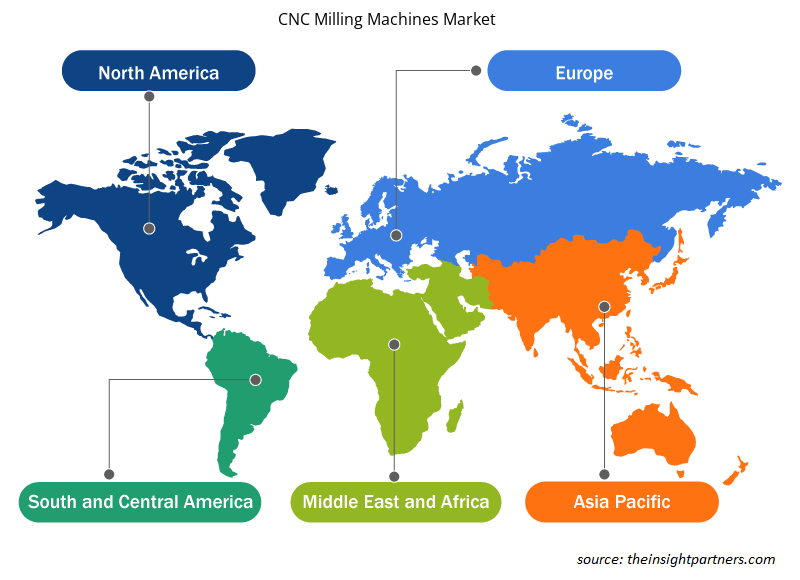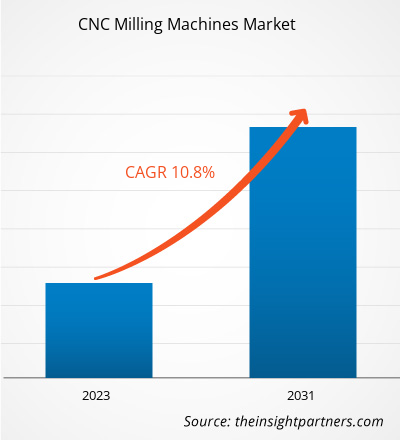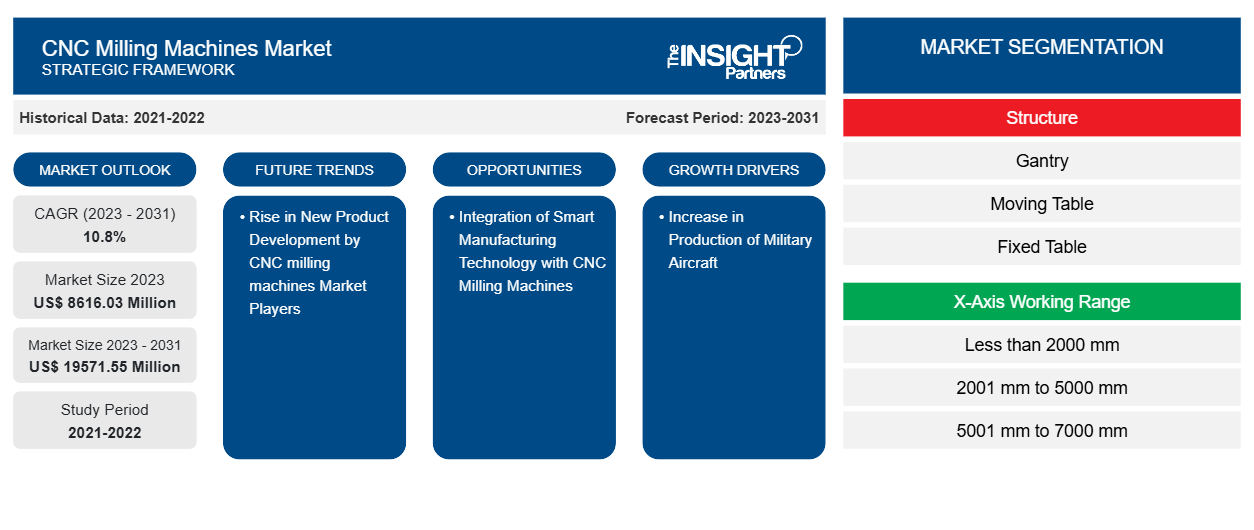Si prevede che il mercato delle fresatrici CNC raggiungerà i 19571,55 milioni di dollari entro il 2031, rispetto agli 8616,03 milioni di dollari del 2023. Si prevede che il mercato registrerà un CAGR del 10,8% nel 2023-2031. La crescente domanda di veicoli elettrici a livello globale sta guidando fortemente l'industria automobilistica. L'industria automobilistica in tutto il mondo sta vivendo cambiamenti significativi, come l'aumento della produzione di veicoli elettrici e veicoli autonomi. Molti produttori di automobili hanno aumentato la loro produzione attraverso l'adozione dell'automazione e l'espansione degli impianti di produzione in tutto il mondo. Secondo l'Agenzia internazionale per l'energia (IEA), le vendite di veicoli elettrici (EV) sono quasi raddoppiate nel 2021 rispetto al 2020, nonostante i colli di bottiglia della catena di fornitura e la pandemia di COVID-19. Nel 2021 sono stati venduti quasi 6,6 milioni di EV e un totale di 16,5 milioni di EV erano presenti sulle strade a livello globale. Nel 2021, in Cina sono stati venduti 3,3 milioni di veicoli elettrici, rispetto a 1,2 milioni nel 2020. L'industria automobilistica è uno dei maggiori utilizzatori di fresatrici CNC. Nell'industria automobilistica, le fresatrici CNC producono pannelli interni, motori di trazione e varie parti personalizzate. La lavorazione CNC aiuta anche l'industria automobilistica a sviluppare prototipi funzionali, che possono entrare in produzione di massa dopo test e convalida. Pertanto, la crescita dell'industria automobilistica sta principalmente guidando il mercato delle fresatrici CNC.
Analisi di mercato delle fresatrici CNC
L'industria automobilistica in tutto il mondo sta vivendo cambiamenti significativi, come l'aumento della produzione di veicoli elettrici e veicoli autonomi. Molti produttori di automobili hanno aumentato la loro produzione attraverso l'adozione dell'automazione e l'espansione degli impianti di produzione in tutto il mondo. Di seguito sono menzionati alcuni dei nuovi impianti di produzione aperti negli ultimi anni:
- A settembre 2021, Ford ha annunciato l'apertura del suo nuovo stabilimento di produzione di veicoli elettrici negli Stati Uniti, con un investimento di 11,4 miliardi di dollari.
- Nel settembre 2022, Continental ha inaugurato il suo nuovo stabilimento di produzione automobilistica in Texas, con un investimento di 110 milioni di dollari.
- Nell'ottobre 2021, Nissan ha annunciato l'apertura del suo nuovo stabilimento produttivo a Tochigi. La fabbrica è impegnata nella produzione di veicoli di nuova generazione per raggiungere la neutralità carbonica.
L'apertura di nuovi stabilimenti di produzione in tutto il mondo sta contribuendo all'aumento della produzione di veicoli. L'aumento della produzione di veicoli in unità in alcuni paesi nel 2022 rispetto al 2021 è menzionato di seguito:
|
Paese
|
2021
|
2022
|
% modifica
|
|
Stati Uniti
|
9.167.214 |
10.060.339 |
10% |
|
Germania
|
3.308.692 |
3.677.820 |
11% |
|
Cina
|
26.082.220 |
27.020.615 |
3% |
|
India
|
4.399.112 |
5.456.857 |
24% |
|
Indonesia
|
1.121.967 |
1.470.146 |
31% |
|
Sudafrica
|
499.087 |
555.889 |
11% |
|
Argentina
|
434.753 |
536.893 |
24% |
Fonte: Organizzazione Internazionale dei Costruttori di Veicoli a Motore
Le fresatrici CNC sono ampiamente utilizzate per la produzione automobilistica, inclusa la produzione di diverse parti come pannelli interni, cambi, parti personalizzate e motori. Pertanto, la crescente produzione automobilistica in tutto il mondo sta guidando la domanda di fresatrici CNC, contribuendo così alla crescita del mercato delle fresatrici CNC.
Panoramica del mercato delle fresatrici CNC
Le fresatrici a controllo numerico computerizzato (CNC) sono le macchine più importanti per la produzione sottrattiva, rimuovendo materiali dal pezzo in lavorazione per creare un prodotto finito. Ciò differisce dai processi di produzione additiva come la stampa 3D, la fusione o lo stampaggio a iniezione in cui il materiale viene aggiunto per creare un prodotto finito. Il processo inizia con una rappresentazione CAD (computer-aided design) bidimensionale o tridimensionale della parte da produrre. Il CAD guida il processo di taglio del pezzo in lavorazione e definisce con precisione le misure e i requisiti per la parte. La fresatura CNC è stato il primo tipo di processo CNC utilizzato nel 1952 e può rimodellare vari materiali come metallo, vetro, lega, plastica o legno. È il processo CNC più comune e può essere programmato per produrre parti progettate su misura secondo specifiche esatte e accurate. Attualmente, molti operatori di mercato offrono un'ampia gamma di prodotti con varie specifiche, dimensioni e funzionalità.
Personalizza questo report in base alle tue esigenze
Riceverai la personalizzazione gratuita di qualsiasi report, comprese parti di questo report, o analisi a livello nazionale, pacchetto dati Excel, oltre a usufruire di grandi offerte e sconti per start-up e università
-
Scopri le principali tendenze di mercato in questo rapporto.Questo campione GRATUITO includerà analisi di dati che spaziano dalle tendenze di mercato alle stime e alle previsioni.
Approfondimenti regionali sul mercato delle fresatrici CNC
Le tendenze regionali e i fattori che influenzano il mercato delle fresatrici CNC durante il periodo di previsione sono stati ampiamente spiegati dagli analisti di Insight Partners. Questa sezione discute anche i segmenti e la geografia del mercato delle fresatrici CNC in Nord America, Europa, Asia Pacifico, Medio Oriente e Africa e America centrale e meridionale.

- Ottieni i dati specifici regionali per il mercato delle fresatrici CNC
Ambito del rapporto di mercato sulle fresatrici CNC
| Attributo del report | Dettagli |
|---|---|
| Dimensioni del mercato nel 2023 | 8616,03 milioni di dollari USA |
| Dimensioni del mercato entro il 2031 | 19571,55 milioni di dollari USA |
| CAGR globale (2023-2031) | 10,8% |
| Dati storici | 2021-2022 |
| Periodo di previsione | 2023-2031 |
| Segmenti coperti |
Per struttura
|
| Regioni e Paesi coperti |
America del Nord
|
| Leader di mercato e profili aziendali chiave |
|
Densità dei player del mercato delle fresatrici CNC: comprendere il suo impatto sulle dinamiche aziendali
Il mercato delle fresatrici CNC sta crescendo rapidamente, spinto dalla crescente domanda degli utenti finali dovuta a fattori quali l'evoluzione delle preferenze dei consumatori, i progressi tecnologici e una maggiore consapevolezza dei vantaggi del prodotto. Con l'aumento della domanda, le aziende stanno ampliando le loro offerte, innovando per soddisfare le esigenze dei consumatori e capitalizzando sulle tendenze emergenti, il che alimenta ulteriormente la crescita del mercato.
La densità degli operatori di mercato si riferisce alla distribuzione di aziende o società che operano in un particolare mercato o settore. Indica quanti concorrenti (operatori di mercato) sono presenti in un dato spazio di mercato in relazione alle sue dimensioni o al valore di mercato totale.
Le principali aziende che operano nel mercato delle fresatrici CNC sono:
- Società Okuma
- Società Nidec
- NICOLA CORREA
- SA
- AWEA MECHANTRONIC CO., Ltd
- EMCO GmbH
Disclaimer : le aziende elencate sopra non sono classificate secondo un ordine particolare.

- Ottieni una panoramica dei principali attori del mercato delle fresatrici CNC
Notizie di mercato e sviluppi recenti sulle fresatrici CNC
Il mercato delle fresatrici CNC viene valutato raccogliendo dati qualitativi e quantitativi dopo la ricerca primaria e secondaria, che include importanti pubblicazioni aziendali, dati associativi e database. Di seguito è riportato un elenco degli sviluppi nel mercato per innovazioni, espansione aziendale e strategie:
- A gennaio 2023, EMCO e GLM sono in cammino verso EMCO GLM GMBH. Dopo una fase preparatoria di grande successo, in cui la cooperazione delle due aziende nei settori delle vendite, della tecnologia applicativa, dell'automazione e dell'assistenza è già iniziata, è stata avviata la fondazione della nuova azienda EMCO GLM GmbH, con una quota di maggioranza di EMCO. (Fonte: EMCO, comunicato stampa)
- A dicembre 2022, TRIMILL ha consegnato con successo una fresatrice TRIMILL VFC 3021 a 5 assi a un cliente in Germania. La fresatrice è dotata di una testa di fresatura a forcella a 2 assi T21C, progettata per la fresatura continua e offre elevata precisione e rigidità. TRIMILL ha affermato di fornire ai propri clienti soluzioni di fresatura personalizzate e di alta qualità, nonché la sua capacità di consegnare e installare macchine in tutto il mondo con successo. (Fonte: TRIMILL, comunicato stampa)
Copertura e risultati del rapporto di mercato sulle fresatrici CNC
Il rapporto "Dimensioni e previsioni del mercato delle fresatrici CNC (2021-2031)" fornisce un'analisi dettagliata del mercato che copre le seguenti aree:
- Dimensioni e previsioni del mercato delle fresatrici CNC a livello globale, regionale e nazionale per tutti i principali segmenti di mercato trattati nell'ambito dell'articolo.
- Dinamiche di mercato come fattori trainanti, vincoli e opportunità chiave
- Tendenze del mercato delle fresatrici CNC
- Analisi dettagliata delle cinque forze PEST/Porter e SWOT
- Analisi di mercato delle fresatrici CNC che copre le principali tendenze del mercato, il quadro globale e regionale, i principali attori, le normative e i recenti sviluppi del mercato
- Analisi del panorama del mercato delle fresatrici CNC e della concorrenza, che comprende la concentrazione del mercato, l'analisi della mappa di calore, i principali attori e gli sviluppi recenti.
- Profili aziendali dettagliati
- Analisi storica (2 anni), anno base, previsione (7 anni) con CAGR
- Analisi PEST e SWOT
- Valore/volume delle dimensioni del mercato - Globale, Regionale, Nazionale
- Industria e panorama competitivo
- Set di dati Excel
Report recenti
Testimonianze
Motivo dell'acquisto
- Processo decisionale informato
- Comprensione delle dinamiche di mercato
- Analisi competitiva
- Analisi dei clienti
- Previsioni di mercato
- Mitigazione del rischio
- Pianificazione strategica
- Giustificazione degli investimenti
- Identificazione dei mercati emergenti
- Miglioramento delle strategie di marketing
- Aumento dell'efficienza operativa
- Allineamento alle tendenze normative























 Ottieni un campione gratuito per - Mercato delle fresatrici CNC
Ottieni un campione gratuito per - Mercato delle fresatrici CNC